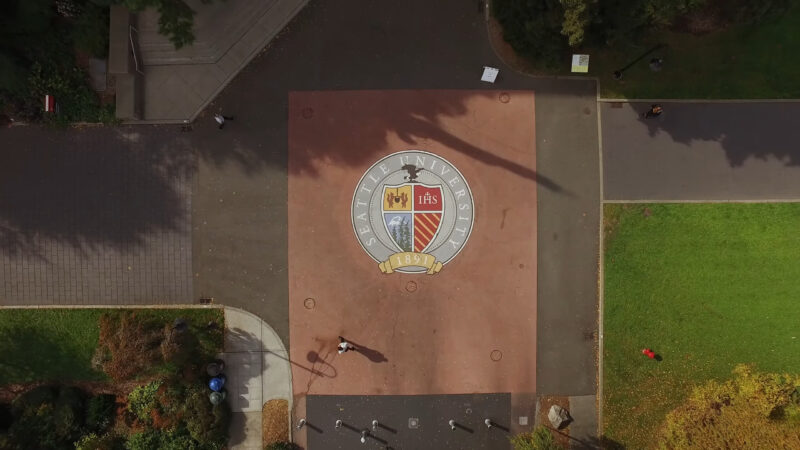Contemplating higher education in Seattle requires evaluating which university aligns best with your needs.
Seattle University and the University of Washington stand out as the city’s leading and most esteemed educational institutions, each with its unique traits, strengths, and challenges to consider.
In this post, I will compare these two universities, focusing on aspects like location, cost, admission criteria, academic offerings, outcomes, diversity, and campus life.
My goal is to offer insights that assist you in making a well-informed and assured decision for your educational journey ahead. There’s a lot to cover, so let’s begin.
Location
Seattle University and the University of Washington, situated in the renowned city of Seattle, share a common geographic location near the iconic Space Needle. However, their campuses sport distinct settings and environments that set them apart from one another.
Seattle University is situated in the First Hill neighborhood, east of downtown Seattle. It has a 50-acre campus that is close to many cultural, artistic, and civic attractions, such as the Seattle Art Museum, the Paramount Theatre, and the Seattle Public Library.
The last time I visited, the campus was easily accessible by public transportation, such as buses and light rail. University of Washington, on the other hand, has a 703-acre main campus in the University District, north of downtown Seattle.
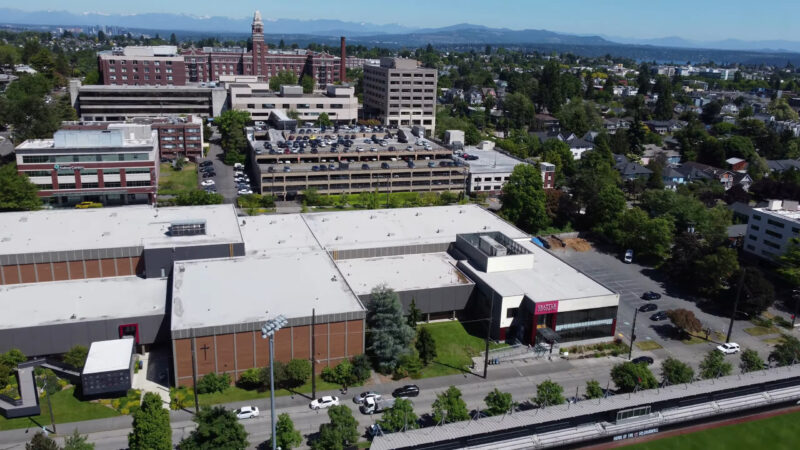
It also has satellite campuses in Tacoma and Bothell. The main campus is surrounded by natural beauty, such as Lake Washington, the Montlake Cut, and the Arboretum.
It also has many historic and iconic buildings, such as the Suzzallo Library, Drumheller Fountain, and the Husky Stadium. The place is well-connected by buses, light rail, and the Burke-Gilman Trail.
Campus Size and Setting
Seattle University has a 50-acre campus, creating a tight-knit community feeling. It’s in a big city, so it feels lively and active.
In comparison, the University of Washington’s campus is much larger at 703 acres, offering lots of space for facilities and activities, also in a big city setting.
Nearby Attractions
For things to do nearby, Seattle University is close to downtown Seattle.
This means students can easily visit places like the Seattle Art Museum, Paramount Theatre, and Seattle Public Library.
The University of Washington is near Lake Washington, providing beautiful views and chances to enjoy nature through places like the Montlake Cut and Arboretum.
Transportation Options
Getting around is important for students. Seattle University is well-connected by buses and light rail, making it easy to get around the city.
The University of Washington also offers good bus and light rail connections, plus the Burke-Gilman Trail.
This trail is great for walking and biking, offering a green way to commute and helping to build a sense of community.
Cost

When selecting a university, it’s crucial to assess the total cost of attendance. This includes tuition, fees, accommodation and meals, textbooks, and materials, along with other personal expenditures.
The total cost varies based on your residency status (in-state or out-of-state) and any financial assistance received, including grants, scholarships, loans, or work-study programs. Seattle University, a private institution, maintains the same tuition and fees for all students, regardless of residency.
Here’s a detailed graphics comparing expenses you should expect for both universities:
Tuition and Fees
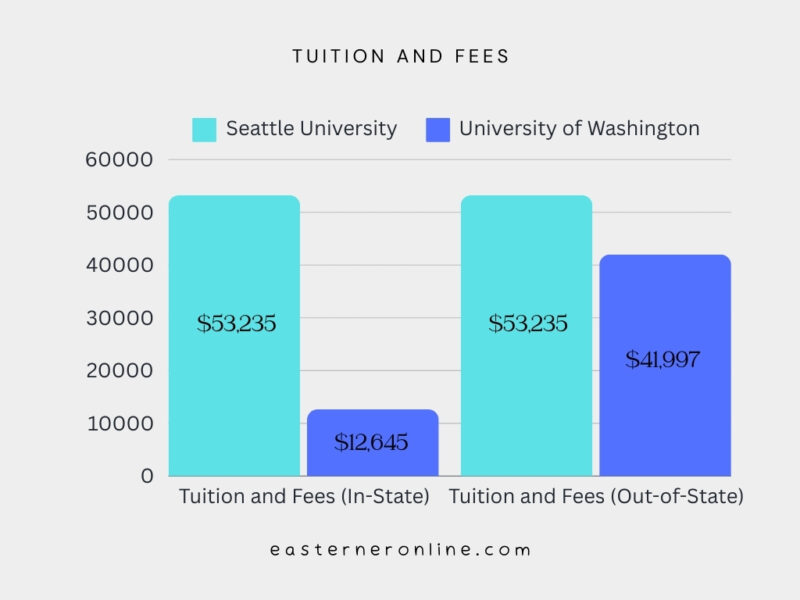
Seattle University sets a flat tuition rate of $53,235 for all students, reflecting its private status and uniform pricing regardless of residency.
In contrast, the University of Washington offers a significant reduction for in-state students at $12,645, while out-of-state attendees are charged $41,997, highlighting the financial advantage for residents due to its public university nature.
Room and Board
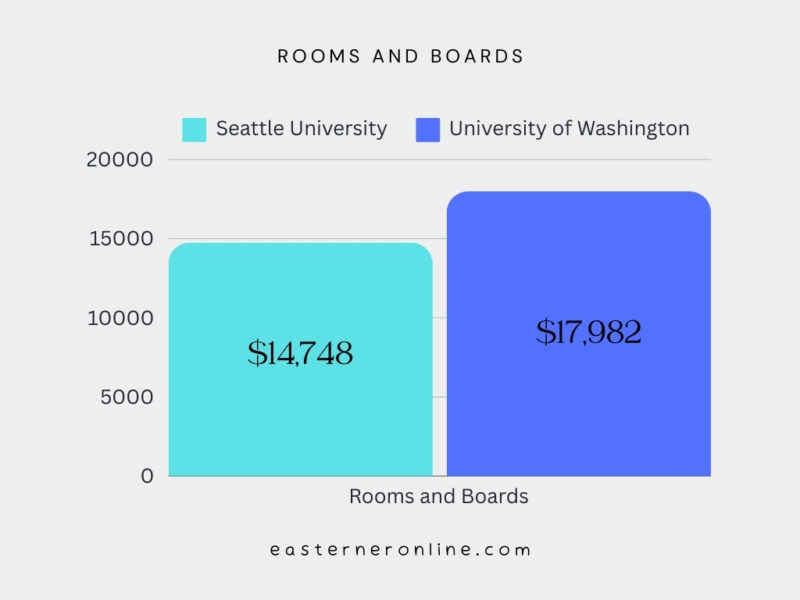
Living expenses are a considerable part of college budgets, with Seattle University demanding $14,748 and the University of Washington slightly higher at $17,982.
This points to the general cost of living in Seattle, an essential element for student budgeting.
Books and Supplies
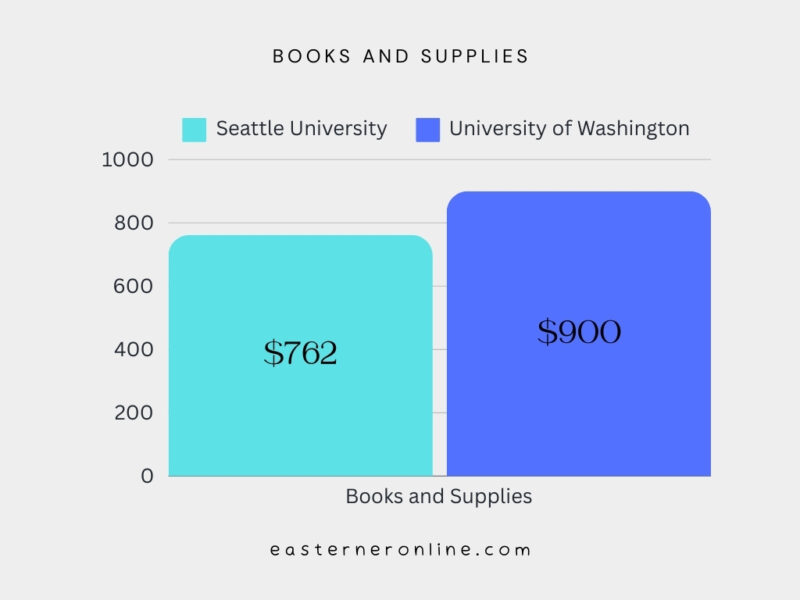
Expenses for books and supplies hover around $762 at Seattle University and $900 at the University of Washington.
This shows a relatively minor difference, indicating similar academic expenses across both institutions.
Other Expenses

Seattle University and the University of Washington differ in their estimates for personal and transportation costs. Seattle University’s estimates stand at $1,950 for personal expenses and $1,800 for transportation.
Conversely, the University of Washington expects personal/miscellaneous expenses to be about $2,508, with a lower transportation cost of $519, underlining the need to consider personal lifestyle and commuting expenses.
Total Cost of Attendance
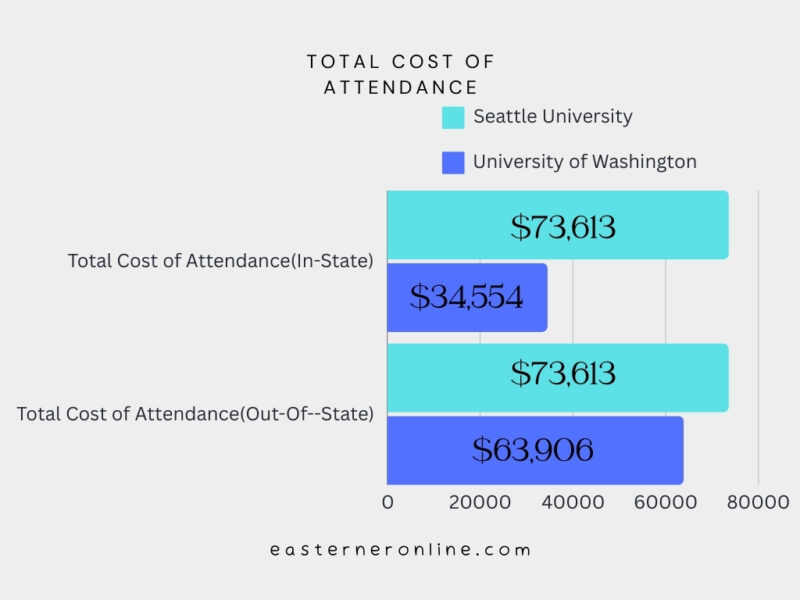
The overall financial commitment is markedly different between the two schools.
Seattle University’s cost of attendance is pegged at $73,613 for both in-state and out-of-state students.
The University of Washington, however, shows a split picture: $34,554 for in-state students and $63,906 for out-of-state, encapsulating the varying scales of financial investment required.
Average Net Price and Aid
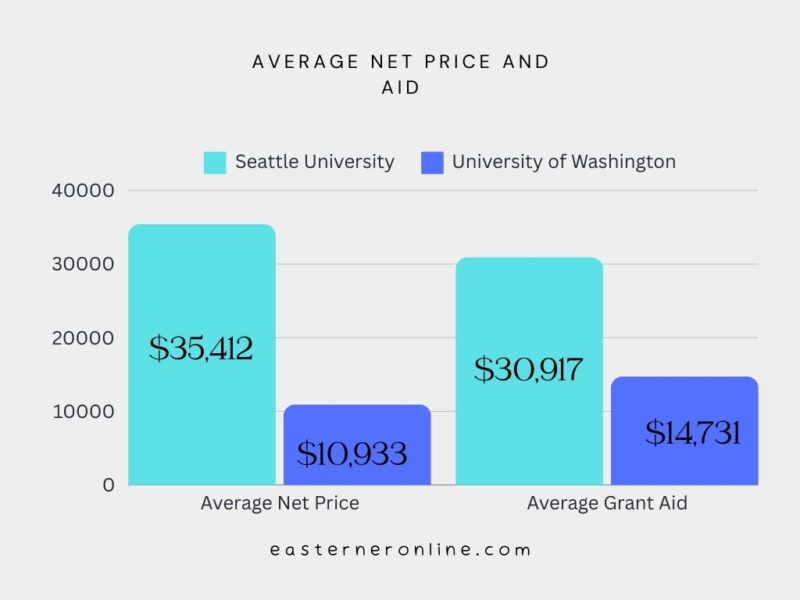
Financial aid considerations reveal that Seattle University’s average net price comes to $35,412, a figure substantially higher than the University of Washington’s $10,933 for in-state students.
This underscores the role of financial aid in making education accessible.
The average grant aid at Seattle University is $30,917, compared to $14,731 at the University of Washington, reflecting their distinct approaches to supporting students financially.
Student Loan Debt
The median student loan debt also sheds light on the financial outcomes for graduates, with Seattle University alumni typically incurring $24,500 in debt, in contrast to $15,000 for those from the University of Washington. This aspect hints at the long-term financial considerations that students must weigh.
Admission

When evaluating universities, the admissions process and criteria are key factors. These elements indicate a university’s selectivity and competitive nature, as well as the academic caliber and potential of its candidates.
Components of the admissions process include application deadlines, acceptance, and enrollment rates, average high school GPAs, typical grades, standards for admission, level of competition among applicants, and policies regarding test scores. According to Seattle University’s official website, they set their regular decision deadline for January 15 and early action for November 15.
With an 85% acceptance rate, it admits roughly 8 in 10 applicants. Its enrollment rate stands at 14.2%, meaning approximately 1 in 7 accepted students opt to enroll.
The average high school GPA for admitted students is 3.62, with B+ being the common grade range. Seattle University presents challenging admission criteria and experiences low competition among applicants.
While it considers ACT or SAT scores, they are not mandatory for admission. Conversely, the University of Washington’s regular decision deadline is November 15, without options for early action or decision. According to their official website, admission decisions are made only after all freshman applications have been reviewed.
It accepts about 5 in 10 applicants, reflected in its 48% acceptance rate. About 3 in 10 admitted students, indicated by a 27.8% enrollment rate, decide to enroll.
The average high school GPA here is 3.82, typically within the A- grade range. The University of Washington is known for its stringent admission standards and faces intense competition among applicants.
It neither requires nor recommends ACT or SAT scores for admission.
Application Deadlines
Seattle University offers two application deadlines: Early Action on November 15 and Regular Decision on January 15, providing options for early applicants.
The University of Washington, however, has a single deadline for Regular Decision on November 15, simplifying the process with one key date.
Acceptance and Enrollment Rates
The acceptance rates reveal Seattle University’s more inclusive approach, accepting 85% of applicants, whereas the University of Washington is more selective, with a 48% acceptance rate.
Despite this, the University of Washington has a higher enrollment rate at 27.8%, compared to Seattle University’s 14.2%, indicating that a larger percentage of those accepted choose to attend the University of Washington.
Academic Credentials
When it comes to academic credentials, Seattle University’s incoming class typically has an average high school GPA of 3.62, around the B+ range.
The University of Washington’s admitted students have a slightly higher average GPA of 3.82, closer to an A-, pointing to stricter academic requirements.
Admissions Standards and Competition
Seattle University’s admissions are described as difficult, welcoming a broad range of students, while the University of Washington is noted for its exceptional standards, attracting a highly competitive applicant pool.
This is evident in the competitive nature of applications, which is considered low at Seattle University but high at the University of Washington, showcasing the latter’s rigorous selection process.
Test Scores Policy
On the topic of standardized test scores, Seattle University remains flexible by considering them but not making them mandatory.
The University of Washington takes a step towards inclusivity by neither requiring nor recommending test scores, focusing on a holistic review of each applicant’s credentials.
Academics
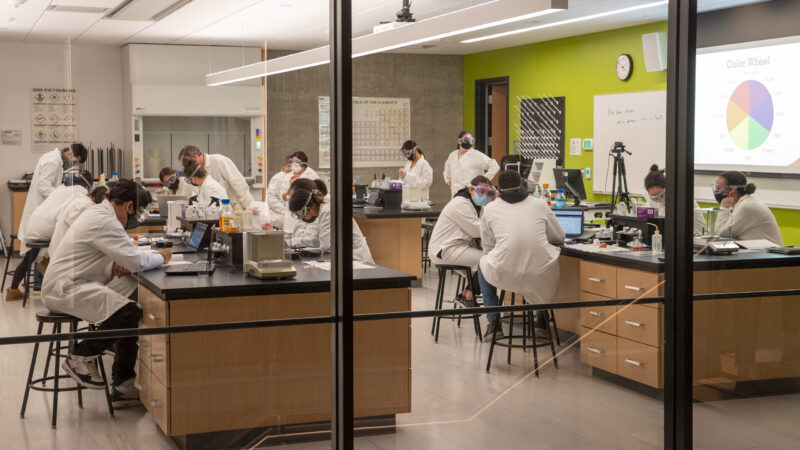
Considering a university also involves evaluating its academic excellence and variety. These aspects mirror the curriculum’s rigor and pertinence, the faculty’s expertise and involvement, student support and achievement, and the research’s impact and innovation.
Key indicators of a university’s academic quality and diversity encompass the ratio of students to faculty, prevalent majors, graduation rates, median graduate earnings, and research funding. Seattle University boasts a student-to-faculty ratio of 11:1, signifying substantial personal attention and interaction between students and educators.
Its most sought-after majors include business, health professions, social sciences, English and literature, and psychology. Approximately 7 in 10 students at Seattle University graduate within six years, as indicated by its 71% graduation rate.
Graduates from Seattle University earn a median salary of $60,400 ten years post-enrollment, surpassing the national average by 36%. Its research spending is $3.4 million, modest in comparison to other institutions.
The University of Washington, on the other hand, has a student-to-faculty ratio of 21:1, suggesting a reasonable level of personal engagement between students and faculty. Popular majors here are social sciences, business, biology, engineering, and communication.
The graduation rate at the University of Washington stands at 80%, with about 8 in 10 students completing their degrees within six years. University of Washington alumni earn a median income of $65,800 a decade after starting at the university, 44% higher than the national average.
Its research budget is a substantial $1.41 billion, ranking 5th nationally.
Student-to-Faculty Ratio
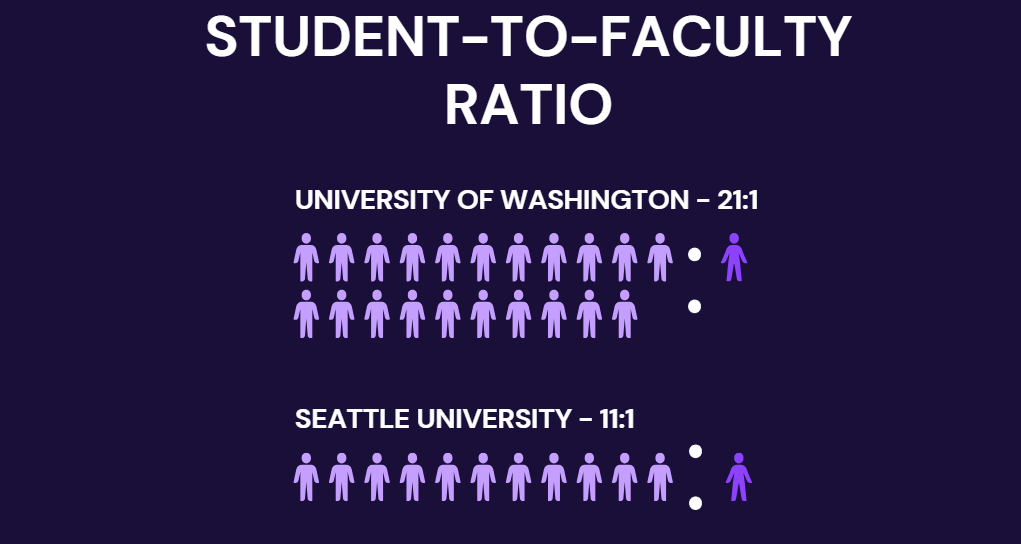
The student-to-faculty ratio presents a clear distinction between the two universities, with Seattle University offering a more intimate learning environment at 11:1 compared to the University of Washington’s 21:1.
This difference could influence the level of personal attention and interaction students can expect from their professors.
Popular Majors
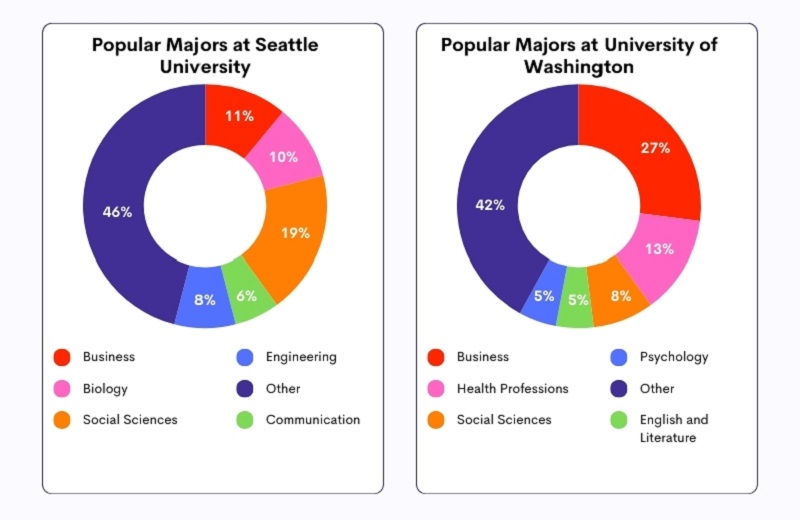
When it comes to the subjects students are most drawn to, both universities showcase diverse interests.
At Seattle University, business leads the pack at 27%, followed by health professions (13%), social sciences (8%), English and literature (5%), and psychology (5%).
The University of Washington has its largest group in social sciences (19%), with business (11%), biology (10%), engineering (8%), and communication (6%) rounding out the top five.
This reflects both institutions’ wide range of academic offerings catering to various student interests.
Graduation Rate
Graduation rates also vary, with Seattle University at 71% and the University of Washington higher at 80%.
This metric is crucial as it indicates the percentage of students who complete their degrees within an expected time frame, suggesting the University of Washington’s slightly more effective support and resources towards student completion.
Research Expenditure
A stark contrast is observed in research expenditure, with Seattle University spending $3.4 million compared to the University of Washington’s substantial $1.41 billion.
This significant difference underscores the University of Washington’s heavy emphasis on research activities and opportunities, positioning it as a leading research institution with vast resources dedicated to innovation and discovery.
Outcomes
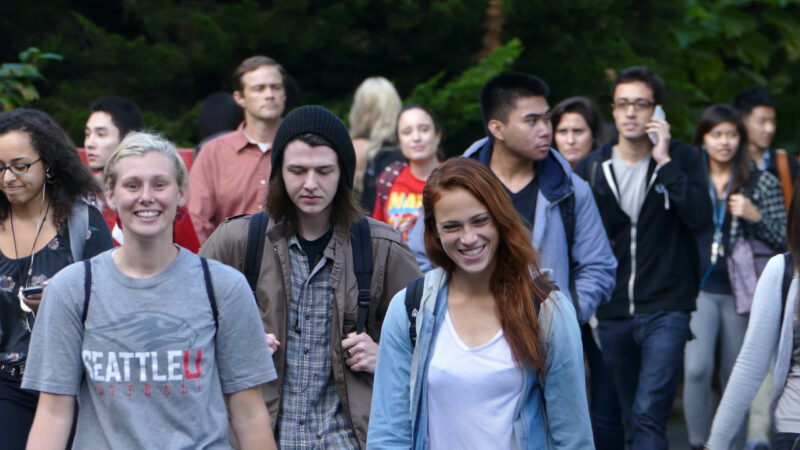
Another significant factor to consider when choosing a university is the outcomes and opportunities of the university. The outcomes and opportunities of the university reflect the value and return of the education, the satisfaction and feedback of the alumni, the recognition and reputation of the degree, and the career and professional development of the graduates.
Seattle University boasts a 98% success rate for its undergraduates, as per the National Association of Colleges and Employers (NACE) Class of 2021-2022 First Destination Survey.
This indicates that within six months post-graduation, 98% of its graduates were either employed, pursuing further education, or involved in military or volunteer services. The average initial salary for Seattle University graduates is $60,400, standing 36% higher than the national average.
Graduates from Seattle University have expressed high contentment with their academic experience, particularly valuing education in writing, citizenship, and their major. The university’s alumni network is robust, comprising 84,000 members across every state and 93 countries, and it actively fosters connections and engagement among alumni through various programs and events.
The University of Washington’s alumni network is extensive and varied, with over 500,000 members globally. It provides numerous services and benefits to its alumni, including career coaching, mentoring, networking opportunities, and lifelong learning resources.
Bottom Line
Choosing between Seattle University and the University of Washington is like picking your new favorite coffee spot in the heart of Seattle – it all comes down to your vibe and flavor. Seattle U, with its intimate class sizes and Jesuit values, offers a tight-knit community and a focus on social justice. UW, on the other hand, is your big-league player with a sprawling campus and a buffet of resources that might just satisfy your academic appetite.
So, whether you’re leaning towards the personal touch of Seattle U or the dynamic pulse of UW’s larger setting, both institutions promise quality education and experience. Take a sip, savor the notes, and trust your gut – your perfect academic blend is waiting for you!

